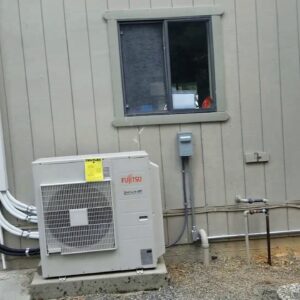Comprehensive Guide to Installing a Fujitsu 45 K5 Zone HVAC System
Introduction
For those seeking to modernize their home’s HVAC system, replacing antiquated or inefficient units with state-of-the-art technology is a monumental step forward. The Fujitsu 45 K5 zone HVAC system offers a robust and versatile solution to ensure all your heating and cooling needs are met with groundbreaking efficiency. This article will walk you through the process of installing this advanced system, providing a practical guide along with the critical considerations for a seamless installation experience. Drawing inspiration from the end-to-end walkthrough we documented on our latest project, let’s dive into the essentials.
Electrical Setup
Assessing the Electrical Panel
The first leg of our journey begins with understanding the heart of your installation—your home’s electrical panel. Prior to adding any new HVAC equipment, it’s crucial to evaluate the existing electrical load to ensure the panel can accommodate the new system.
-
Inspection: Open your electrical panel and utilize a load calculator to ascertain the load on each circuit. Ensure there’s sufficient capacity for the additional load the Fujitsu system will place. Consulting with a licensed electrician is highly recommended.
- Wiring Plan: Post-inspection, sketch out a wiring plan that indicates the route from the panel to each unit, wiring configurations, and necessary breakers.
Conduit & EMT Installation
Having mapped out the wiring plan, we’re now set to install the electrical conduit and EMT (Electrical Metallic Tubing). Proper conduit installation is essential for protecting wiring and ensuring longevity and safety.
-
Material Selection: For our project, we opted for EMT due to its robustness and easy installation process. EMT is particularly suited for environments where rodents or damp conditions are a concern.
-
Running Conduit: Begin by running the EMT conduit from the panel towards the HVAC units. Secure it using appropriate fasteners and straps, ensuring it is well-supported and follows a clean, straight path. Conduits should enter the panel at the designated knockouts, ensuring a tight fit.
- LB Connectors: Use LB connectors to make 90-degree turns with EMT. These connectors protect wires from sharp bends and provide an access point to pull wires through.
Wiring the Systems
The next step is to pull the wires through the conduit and connect them appropriately.
-
Circuit Breakers: Install appropriate circuit breakers in the panel according to the HVAC system’s specifications, typically found in the user manual.
-
Disconnect Switch Installation: Next, install a disconnect switch close to the units. This provides a means to quickly disconnect power during maintenance or emergencies. Ensure the switch meets local electrical codes and standards.
- Wiring to Units: Connect the wires from the disconnect switch to the HVAC units following the wiring plan. Label each wire for easy identification during maintenance.
Refrigerant Lines Installation
Material Preparation
Moving onto the refrigerant lines, gather all necessary materials including copper lines, insulation, and fittings.
-
Copper Lines: Use high-quality copper refrigerant lines. Measure and cut to the required length, ensuring tight and consistent fittings.
- Insulation: Proper insulation of the refrigerant lines is critical to maintain efficiency and prevent losses. Use closed-cell foam insulation specifically designed for refrigerant lines.
Line Installation
-
Routing Lines: Route the refrigerant lines from the outdoor unit to the indoor units, ensuring they are tucked tightly behind the structure to protect them and maintain a clean appearance.
- Supporting Lines: Use straps and brackets to secure the lines. Uniform strapping at regular intervals ensures the lines remain in place and reduces potential vibration noise.
Indoor Unit Setup
Installation Locations
Our specific project involved multiple indoor units to ensure thorough climate control across two levels. Each unit’s strategic placement guarantees optimal coverage and efficiency.
-
Downstairs Unit: The downstairs area, encompassing the kitchen and dining, was served by a 2-ton unit positioned centrally for maximum airflow.
- Upstairs Cassette Units: The upstairs area utilized ceiling cassettes, which are recessed into the ceiling space. These units are incredibly silent, ideal for sleeping areas or family rooms.
Thermostat Integration
For precise temperature control, each unit is coupled with a wall-mounted thermostat.
-
Mounting Thermostats: Place thermostats on interior walls away from direct sunlight, drafts, or other sources of heat. This positioning ensures accurate temperature readings.
- Wiring Thermostats: Connect the thermostats to the respective units following the manufacturer’s instructions. Use labeled wires to prevent confusion during the installation process.
Drainage Solutions
One crucial consideration often overlooked is the drainage for the HVAC system. Efficient and clean drainage can prevent water damage and mold growth.
Gravity Drainage
For efficiency and simplicity, gravity drainage was chosen over using a pump. This method relies on sloping drain lines to facilitate water exit without mechanical assistance.
-
Drain Line Installation: Run the drain lines from the indoor units straight down to an appropriate exit point. Ensure the drain lines are securely fastened and insulated where necessary to prevent condensation.
- Penetration Points: Create small penetration points on the lines where needed to allow for water diversion without compromising the aesthetic of the installation.
Final Touches
Once all components are in place and connected, it’s time to finalize the installation with system checks and calibration.
System Checks
-
Electrical Safety: Verify all electrical connections are secure and compliant with local codes. Use a multimeter to check voltage levels and continuity.
-
Leak Testing: Test refrigerant lines for leaks using a combination of visual inspection and electronic leak detectors. Any detected leaks must be repaired before proceeding.
- Thermostat Calibration: Turn on the system and calibrate each thermostat to ensure accurate temperature settings and response.
Performance Testing
-
Operational Check: Activate the system in both heating and cooling modes to ensure it reaches desired temperatures efficiently. Monitor the noise levels to confirm the system operates quietly.
- Balance Airflow: Adjust the vents and unit settings to balance the airflow throughout the house, ensuring even temperature distribution.
Inspector Review
Finally, schedule an inspection with a local building authority to approve the installation. This includes verifying compliance with electrical codes, refrigerant line safety, and overall system performance.
Conclusion
Installing a Fujitsu 45 K5 Zone HVAC system is a meticulous process that requires careful planning and precise execution. From assessing the electrical panel to final system performance checks, every step ensures the system operates safely, efficiently, and quietly. With comprehensive preparation and attention to detail, your home will enjoy unparalleled climate control for years to come.
Modern HVAC systems like the Fujitsu 45 K5 are highly efficient, environmentally friendly choices that offer substantial energy savings and comfort improvements. If you’re not confident in tackling this installation yourself, hiring a professional HVAC technician is a wise investment for peace of mind and optimal performance. Thank you for following along in this detailed installation guide. With patience and diligence, you can achieve a top-tier HVAC installation that elevates your living environment.

